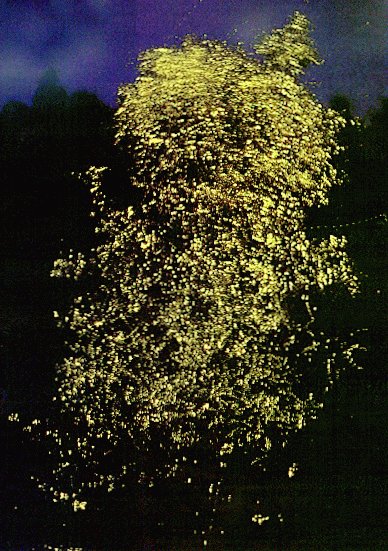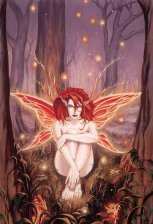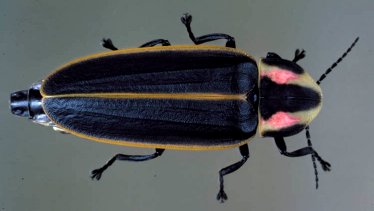Because I am of a skeptic nature, I thus prefer to examine closely what is put forth as foundation for this idea rather than to accept it as valid without making the necessary checking.
I noted that this so-called "absurdity of ET", and these mixing together with phenomena attributed to the "paranormal", rest on a certain number of errors, sometimes huge errors and a casebook which does not reveal any "paranormal" but very "normal" things, generally indeed without any relevance to the UFO problem.
As it is not enough to just say this, I publish a collection of my discoveries which found my opinion:
I honestly admit it: I completely forgot that I was a scientist by profession when I began the manuscript of "Passport to Magonia"." [1]
Source:
Jacques Vallée reported the story. He arranged for some sensation as for the identity of the witness, who is the celebrated German poet Goethe, reporting in Book 6 of his autobiography, according to Kenneth Anger who told about it to Vallée.
This is how the story is published, the event taking place in September of 1768:
|
"... He was aged 16 and was traveling to the Leipzig University. The travel was painful, under a heavy rain and in the hillsides, the travelers had to get down to relieve the effort of the horses. During one of these forced walks, he noticed an astonishing phenomenon: "Suddenly, in a ravine on the right of the road, I saw a kind of amphitheater, marvelously illuminated. In a space in the shape of a pipe, shone a large number of small lights were posed like steps the ones on the others. They shone so intensely that the eye was dazzled by it. But what was more disturbing in this vision, is that the lights were not motionless, they jumped about, beyond, went up to down and vice versa, in all the directions. The greatest number of them however remained stable and radiated. It with the greatest displeasure that I agreed, when I was called, to get away of this display which I would have really wished to examine more closely. The postilion, when I questioned him, declared that he had never been informed of such a phenomenon, but that there was an old stone quarry in the vicinity of which the excavation was filled with water. It remains to be known, whether that was an assembly of goblins, or an assembly of luminous creatures, I could not decide." [2] |
Source:
Later, a doctor with an interest in the ufology, Jacques Scorneaux, and Christiane Piens, gave a quite "saucerized" version of the story given by Vallée, who is cited as source, - I bolded the unjustified words -:
|
The young man noticed a strange luminous object in a ravine... Were they lights on the craft or small mobile objects? [3] |
Source:
After the narrative, it seems to me that Vallée asks his readers, in a somehow ambiguous manner: Wouldn't Goethe have reported a "UFO with occupants" sighting if this sighting had occurred in the present time?
I cannot answer such a question; it would be necessary to consider as serious a series of assumptions to answer by the affirmative or the negative. But we can imagine that Goethe passed on his report to me, and see what I, as a ufologist, in 2005, would have said of such a report.
I am not a ufologist who professes that the fairies and goblins stories and other stories of the old times are "similar to UFO reports." Valley sometimes uses this concept to deduce from it that the UFOS are not extraterrestrial because they are "like the fairies", sometimes to deduce that the fairies are sorts of "ultraterrestrial" or "interdimensional" creatures" and thus, so are UFOS in his opinion.
Actually, it generally more seems like he does not know what to think. This did not prevent - in spite of his call for cautiousness at the beginning of his book, in particular when he points out that he does not write the book as a scientist - this did not prevent other to draw completely opposite and different conclusions. One is that since fairies do not exist, UFOs do not exist either, since fairies and UFOS are the same phenomenon. The other is that since it is the same phenomenon, fairies and goblins are simply extraterrestrial visitors, described in the language of the past.
I rather choose to check if a simple explanation of this report can be found. So, let's see the report by witness Goethe in depth.
Although there is only a unique witness, which should be enough to put the report as a totally unconfirmed report, although the status of Goethe does not the least deserve to be seen as a qualified observer of the nature but rather as somebody having for occupation to make nature more marvelous than it is it, it is possible to think rationally in order to find what he describes.
He sees a sort of amphitheater in a ravine. Let's forget the theatrical interpretation and note that an amphitheater is not an UFO, because it does not fly and is not "unidentified". Goethe tells about a sort of amphitheater, therefore there is a kind of half round place, which shows out from the landscape's background, something noticeable. That is a rather bland anomaly, not "a UFO", something of such low strangeness that I cannot grasp how anyone can come to the notion that it could be a spaceship.
Goethe is unfamiliar with the area, so it is only normal that he sees some feature that he does not understand and thus finds strange. In modern ufology investigations, this is classic: we know, or we should know, that there can be a huge difference between seeing a "anomaly" in perfectly familiar ground, and seeing a "anomaly" in a foreign place, in a place where the witness never saw before, and moreover in heavy rain and the middle of the night as we will see.
At that point, any investigator should wonder whether somebody who would be familiarized with the location could help to identify this sort of amphitheater.
Well, by chance, Goethe himself to care to check: he later questions the postilion, and the postilion gives the solution: he doesn't know about the lights, but there is an old stone quarry in the area. the amphitheater is in all likeliness exactly this old stone quarry.
Experienced UFO investigators know just like I know, that the simple solutions, when there are simple solutions, are often involuntarily or unconsciously provided by the witnesses in their reports.
We have thus some reasons to think that the "sort of amphitheater" is this career, as the postilion suggests it, and not "an UFO", nor a true amphitheater.
Now, the report contains other apparently strange items. The following is that of the "large number of small lights." Those lights jump to and fro, except the larger number; which do not move.
Goethe gave a description; let's forget his "pandemonium of goblins" proposed interpretation and see whether his own other proposal "luminous creatures", has a match. Indeed, Goethe himself hesitates between the two, indicating that it "remains to know" which is the right one, and that he thinks that he would have known if he had not agreed to move away when he was called, if he had the chance to look further. This indicates that he is a rational mind vis-a-vis with the observation. This also indicates the low strangeness of the sighting: after all, if he is not very sure that these are goblins and just as easily considers that can be an assembly of luminous creatures, then the "goblin" side of the creatures is far from being really well observed.
Now, are there such luminous creatures, which would not be goblins, but quite ordinary luminous creatures?
Yes there are.
Once that I had the idea of this explanation, I naturally searched for some information on these insects. I knew what a firefly is, I know it produces light, I imagined without difficulty that fireflies could gather in a place - such as a pond in a quarry - I knew that fairies and fireflies are linked together in popular folklore and imagination, but ultimately I am not much of an hexapodist and I wanted to check if there are points of adequacy or inadequacy between my fireflies hypothesis and Goethe's story which I could have missed.
A first point was to see whether there is indeed something like assemblies of fireflies. Goethe evokes a "assembly", and I bet he did not lie, I bet he did not exaggerate: well, that's correct, there really are assemblies of fireflies. The photograph below lets you see how impressive it can be, we really have "a large number" and a "marvelous illumination", as Goethe wrote:

|
A second thing is that Goethe described the behavior of the luminous creatures: the largest number remained motionless, and others jumped to and fro.
This is a good match: this is precisely a known behavior of gathered fireflies: the females emit their light while remaining motionless on the ground, while the males parade by making sudden occasional jumps with a trajectory in the shape of a reversed "J", on heights of about 1 to 2 meters, with their light on. nd the females on the ground answer with their own lights production.
Again, Goethe did not invent or exaggerate.
Fireflies do not emit any visible light in daytime. The account does not specify the time of the sighting, but obviously, it must have been dark, and that explains very well that the natural landscape is poorly understood, and that Goethe evokes "a sort of amphitheater" which makes the postilion, who knows the area, recall that there are quarries there.
I obviously cannot put forth a "final proof" of the explanation by the fireflies; but anyway, to develop a thesis on "extraterrestrial absurdity", luminous goblins and other "mothership" from an account also simply and easily explainable seems totally unjustified to me.
It should be noted that fireflies shows, which was not something very current in this time, became much rarer still in Europe nowadays; the main cause is the use of insecticides which these insects do not tolerate.

|
Above: Fairies and fireflies are still linked together in popular imagination.

|
Above: A firefly (Xexapoda: Coleoptera: Lampyridae).
Goethe saw neither an extraterrestrial spaceship nor goblins nor a paranormal phenomenon. As usual in witnesses' descriptions, and in spite of his statute of poet, his description is sufficiently accurate, and it points at the reasonable possibility that he saw an assembly of fireflies.
It is perfectly unjustified to put forward an "absurdity of the extraterrestrial visitors" using this account which does not describe extraterrestrial craft nor their occupants at all. The only nonsense would be to see anything else here than fireflies.